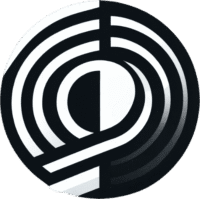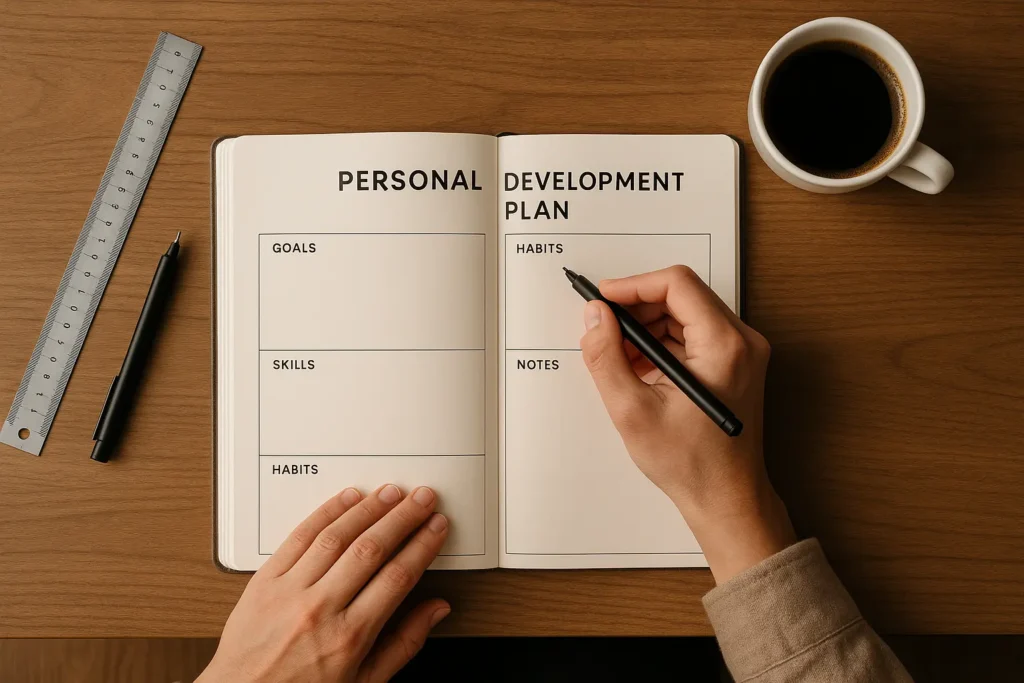Saber que você precisa de um Plano de Desenvolvimento Pessoal é uma coisa; saber como um ótimo Plano de Desenvolvimento Pessoal realmente é outra. Olhar para uma página em branco pode ser intimidador. É fácil ficar preso e se perguntar: “Será que estou fazendo isso direito?”
That’s why we’ve compiled this library of over 10 real-world, actionable Personal Development Plan examples.
These aren’t vague theories. They are practical blueprints for a variety of common goals—from advancing your career and learning a new skill to dramatically improving your well-being. Use them as inspiration, as a template, and as a guide to structure your own plan and turn your ambitions into a clear, actionable roadmap.
These examples were all built using a simple, structured framework. You can get the exact same fillable PDP template we used for free to create your own.
These examples are primarily focused on professionals already in the workforce. If you are a university student, we recommend starting with our tailored guide: Personal Development Plan for Students.

How to Read These PDP Examples
Each example below is a mini-case study that follows the 5 core components of an effective PDP. As you read, notice how each step logically flows into the next:
- The Self-Assessment identifies the starting point and the need for change.
- The SMART Goal defines a clear, measurable destination.
- The Strategies & Actions break down the journey into manageable steps.
- The Resources & Support list the tools needed for the journey.
- The Timeline & Metrics create accountability and define what success looks like.
If you’re not familiar with these 5 components, we highly recommend reading our Mastering Your Personal Development Plan (PDP): A Comprehensive Guide first to understand the framework we’re using.
PDP Examples for Career Advancement

Example 1: The Aspiring Team Lead
Scenario: Sarah’s long-term goal was to transition from being an individual contributor to a leadership role, seeking greater job satisfaction through mentoring others. This PDP was her roadmap for targeted professional development in leadership. To balance this with her demanding project work, she knew she had to improve her time management skills.
- 1. Self-Assessment (SWOT):
- Strengths: Expert-level technical skills, highly respected by peers, very organized.
- Weaknesses: Tendency to micromanage, avoids difficult conversations, limited experience in delegation.
- Opportunities: Company is expanding, creating new leadership roles. My manager is supportive of my growth.
- Threats: Other senior developers are also interested in the role.
- 2. SMART Goal:
- To develop the necessary leadership, delegation, and communication skills to be a top candidate for the Team Lead position, with the goal of applying and being promoted within the next 12 months.
- 3. Strategies & Actions:
- Project: Enroll in and complete the company’s internal “Leadership Essentials” training program.
- Project: Volunteer to lead the upcoming Q3 product update project, focusing on setting clear directions and trusting the team to execute.
- Habit: During my weekly planning, identify at least one task that can be delegated to a junior team member and provide them with clear instructions and support.
- Habit: Read one book on leadership or management each quarter (e.g., “The Making of a Manager,” “Dare to Lead”).
- 4. Resources & Support:
- My current manager (as a mentor).
- The company’s Learning & Development budget for the course.
- Junior developers on the team who are eager to take on more responsibility.
- 5. Timeline & Metrics:
- By end of Q1: Complete leadership course.
- During Q3: Successfully lead the product update project to completion on time.
- Ongoing: Delegate at least 4 significant tasks per month.
- Success Metric: Receive the promotion to Team Lead within 12 months. A secondary metric is to receive positive feedback on leadership skills from my manager and at least 80% of the project team members.
Example 2: The Career Changer
Scenario: Mark’s long-term goal is to find a career that offers more creativity and a greater sense of impact, leading to higher job satisfaction. This PDP is his structured plan for professional development, designed to build a new skill set from scratch. His success depends on excellent time management skills to balance studying with his current full-time job.
- 1. Self-Assessment:
- Strengths: Analytical mindset, detail-oriented, good with data.
- Weaknesses: No formal marketing experience, limited creative portfolio, weak professional network in the marketing industry.
- Opportunities: High demand for data-driven marketers. Abundance of high-quality online courses.
- Threats: Competitive entry-level job market. Potential for a temporary pay cut.
- 2. SMART Goal:
- To successfully transition to a full-time role as a Digital Marketing Specialist within the next 9 months, focusing on a position in SEO or PPC.
- 3. Strategies & Actions:
- Project: Complete the Google Digital Marketing & E-commerce Certificate and the Google Analytics Certification.
- Project: Build a personal portfolio website showcasing my skills.
- Project: Take on 2 small freelance projects (even for a low fee) to gain real-world experience and build the portfolio (e.g., running a Google Ads campaign for a local business).
- Habit: Spend 30 minutes every day on LinkedIn, following marketing influencers, engaging with content, and connecting with professionals in the field.
- 4. Resources & Support:
- Coursera subscription for certifications.
- A subscription to industry blogs like Search Engine Journal and Ahrefs.
- A small budget ($200) for freelance project ad spend.
- 5. Timeline & Metrics:
- Months 1-4: Complete both certifications.
- Months 4-6: Build portfolio website and secure/complete first freelance project.
- Months 7-9: Secure/complete second freelance project and begin applying for at least 10 targeted jobs per week.
- Success Metric: Receive and accept a job offer for a Digital Marketing Specialist role within 9 months.
Example 3: The Freelancer Building a Brand
Scenario: Emily is a freelance graphic designer. She has a steady stream of clients but relies heavily on word-of-mouth. She wants to increase her income and establish herself as an expert to attract higher-paying clients.
- 1. Self-Assessment:
- Strengths: Excellent design skills, strong client relationships.
- Weaknesses: Inconsistent marketing, no personal brand presence, under-pricing her services.
- Opportunities: The creator economy is booming; there’s a high demand for branding experts.
- Threats: The market is saturated with other freelance designers.
- 2. SMART Goal:
- To increase my average project fee by 30% and establish a recognizable personal brand in the “branding for tech startups” niche over the next 12 months.
- 3. Strategies & Actions:
- Project: Redesign my personal portfolio website to specialize in the tech startup niche.
- Project: Create 3 in-depth case studies of my best work to feature on the new site.
- Habit: Post one high-value piece of content (e.g., a design tip, a case study breakdown) on LinkedIn and Instagram twice a week.
- Habit: Dedicate every Friday morning to business development, including pitching 5 new potential clients per week.
- 4. Resources & Support:
- A business coach or mastermind group for accountability.
- Books on pricing strategy (e.g., “Breaking the Time Barrier”).
- A content calendar template.
- 5. Timeline & Metrics:
- By end of Q1: New website and case studies are live.
- By end of Q2: Have a consistent content creation and outreach system in place.
- Ongoing: Track outreach efforts and conversion rates.
- Success Metric: Increase average project fee by 30% by the end of the year. A secondary metric is to gain 3 new clients who specifically mention finding me through my content.
PDP Examples for Skill Development

Example 4: Mastering Public Speaking
Scenario: This plan focuses on a specific skill gap that is hindering David’s professional development. His long-term goal is to become a leader, and overcoming this fear is a critical step. The plan uses structured practice and feedback to build competence, which will directly increase his job satisfaction and effectiveness.
- 1. Self-Assessment:
- Strengths: Deep product knowledge, passionate about his work.
- Weaknesses: High anxiety about public speaking, uses a lot of filler words (“um,” “ah”), tends to speak too quickly.
- Opportunities: His company offers a public speaking workshop. There’s a local Toastmasters club.
- Threats: A colleague is a very polished speaker and is often chosen for high-profile presentations.
- 2. SMART Goal:
- To deliver a confident and clear 10-minute presentation at the quarterly all-hands meeting in 6 months with a 50% reduction in filler words.
- 3. Strategies & Actions:
- Project: Enroll in and actively participate in the company’s 2-day public speaking workshop next month.
- Project: Join the local Toastmasters club and attend meetings twice a month.
- Habit: Practice speaking for 5 minutes every day, recording myself on my phone to identify and reduce filler words.
- Habit: Before every team meeting, spend 10 minutes outlining my key talking points to feel more prepared.
- 4. Resources & Support:
- Toastmasters club membership.
- The book “Talk Like TED” by Carmine Gallo.
- A trusted colleague to practice with and get feedback from.
- 5. Timeline & Metrics:
- Month 1: Join Toastmasters, attend the workshop.
- Months 2-5: Deliver at least 3 speeches at Toastmasters and track filler word count.
- Month 6: Deliver the 10-minute presentation at the all-hands meeting.
- Success Metric: Successfully deliver the presentation and receive feedback from my manager that my confidence and clarity have noticeably improved.
Example 5: Becoming Data Proficient
Scenario: Maria works in HR and realizes that her role is becoming more data-focused. She wants to learn basic data analysis skills to make better, evidence-based decisions.
- 1. Self-Assessment:
- Strengths: Strong understanding of HR processes, good with people.
- Weaknesses: Intimidated by spreadsheets, no experience with data analysis or SQL.
- Opportunities: The company is investing in data analytics tools.
- Threats: Other HR professionals with data skills are more competitive.
- 2. SMART Goal:
- To learn the fundamentals of SQL and advanced Excel to be able to independently create the monthly employee turnover report, automating the process by the end of the next quarter.
- 3. Strategies & Actions:
- Project: Complete an online “SQL for Beginners” course on a platform like DataCamp or Codecademy.
- Project: Complete an “Advanced Excel” course focusing on pivot tables and data visualization.
- Habit: Dedicate 3 hours every week (blocked out in my calendar) to coursework and practice.
- Project: Work with the data analytics team to get read-only access to the relevant database and practice writing queries.
- 4. Resources & Support:
- Company’s education stipend to pay for courses.
- A contact in the data analytics department to act as a mentor.
- Online communities like Stack Overflow for troubleshooting.
- 5. Timeline & Metrics:
- Month 1: Complete SQL course.
- Month 2: Complete Excel course.
- Month 3: Build the automated report.
- Success Metric: Successfully generate the monthly turnover report using my new skills, reducing the time it takes by 75%.
PDP Examples for Personal Well-being

Example 6: Reducing Work-Related Stress
Scenario: Ben is a project manager who consistently feels overwhelmed and burned out. He works long hours, has trouble sleeping, and feels his stress is impacting his health and relationships.
- 1. Self-Assessment:
- Strengths: Highly dedicated, responsible.
- Weaknesses: Poor boundaries (checks email at all hours), doesn’t take proper breaks, relies on caffeine to get through the day.
- Opportunities: His partner is supportive and wants to help. His company has a wellness program.
- Threats: The current project has a tight deadline, which is a major source of stress.
- 2. SMART Goal:
- To reduce my self-reported stress levels from an 8/10 to a 5/10 over the next 90 days by implementing clear boundaries and daily stress-management practices.
- 3. Strategies & Actions:
- Habit: Meditate for 10 minutes every morning using the Calm app before checking my phone.
- Habit: Take a full 30-minute lunch break away from my desk every single workday.
- Habit: Establish a hard stop at 7 PM every night, turning off all work notifications.
- Habit: Replace my afternoon coffee with a 15-minute walk outside.
- 4. Resources & Support:
- A subscription to the Calm app.
- My partner for accountability with the 7 PM work cutoff.
- The company’s wellness program resources.
- 5. Timeline & Metrics:
- Ongoing: Track adherence to the four new habits on a weekly habit tracker.
- Weekly: Record my average stress level (1-10) in a journal every Sunday.
- Success Metric: Achieve a weekly average stress level of 5/10 or lower by the end of the 90-day period.
Example 7: Building a Consistent Fitness Routine
Scenario: Lisa’s long-term goal is to make fitness a sustainable part of her identity, improving her energy and overall job satisfaction. This PDP is a form of professional development for her well-being, recognizing that physical health is foundational. Her plan focuses on building habits and using accountability, requiring good time management skills to schedule her workouts.
- 1. Self-Assessment:
- Strengths: Motivated at the start, enjoys walking and hiking.
- Weaknesses: Hates traditional gyms, gets bored easily, has an “all-or-nothing” mindset.
- Opportunities: A new park with walking trails just opened nearby. A friend also wants to get more active.
- Threats: Busy work schedule makes it easy to find excuses.
- 2. SMART Goal:
- To build a consistent and enjoyable fitness routine by engaging in at least 30 minutes of moderate physical activity, 3 times per week, for the next 12 consecutive weeks.
- 3. Strategies & Actions:
- Habit: Schedule my 3 weekly workouts in my calendar like appointments: Tuesday morning, Thursday evening, Saturday morning.
- Action: Ask my friend to be my “accountability partner” for the Saturday morning walk/hike.
- Action: Create a “menu” of enjoyable activities (walking, hiking, online dance class, cycling) to choose from to prevent boredom.
- Habit: Lay out my workout clothes the night before to eliminate friction in the morning.
- 4. Resources & Support:
- My friend (accountability partner).
- A good pair of walking shoes.
- A habit-tracking app.
- 5. Timeline & Metrics:
- Weekly: Track completion of my 3 weekly workouts.
- Success Metric: Do not miss more than one scheduled workout in any two-week period for the next 12 weeks. The goal is consistency, not perfection.
Create Your Own Plan with Our Free Template
Feeling inspired by these examples? Don’t just admire them—build your own! Download our free, fillable PDP template to get started immediately. It guides you through each of the five core components, making it easy to create a structured and powerful plan that is tailored to your unique goals.

Your Blueprint is Waiting
These examples show that a Personal Development Plan is a flexible and powerful tool that can be adapted to any goal, from earning a promotion to getting a better night’s sleep. The common thread is clarity, structure, and a commitment to action.
Use these blueprints as a starting point, but remember that the most effective plan will be the one that is uniquely your own—one that reflects your values, your ambitions, and your definition of a fulfilling life.
Which of these examples was most helpful for you? Let us know in the comments!


